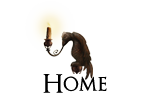Scribble City Central's eighteenth Fantabulous Friday comes from US teen author Julie Kagawa. I'm suspecting that many of my UK readers might not have come across Julie's books...YET. That's about to change, if I have anything to do with it. Her debut novel, The Iron King, came out at the beginning of 2011, and is part of the Iron Fey series, featuring Meghan Chase (an all-American high school student), the faery Prince Ash, and the capricious Puck, along with a cat.
Not just any cat though. A Cait Sith, or faery cat, whose line in dry wit is second to none. We'll meet him in a minute, because his name is *loud trumpet blast* Grimalkin. Julie's faery novels are a mix of myth, legend and a heathy dose of modern industrial techno. There is so much in the 'faery romance' genre now for young adults, but Julie's books work because of her heroine's spot-on teen 'voice', and because the injection of original ideas lifts them above the ordinary.
I've just finished reading the first in Julie's new series, Blood of Eden, which moves into the notoriously crowded world of vampire fiction. It's...well...bloody good, seems an appropriate way to put it. I'm impressed - and I don't impress easily.
Once again, it's an original take and I absolutely loved it. Anyway, enough from me. That Cat is getting impatient, and I don't want to risk being led into a maze of monster-ridden thorns. Without further ado I shall turn you over to Julie who interviews the mystery that is:
G for Grimalkin
Cait Sith and
Guide to the Hidden Paths of Faery
JK: Hello, everyone. I'm Julie Kagawa, author of The Iron Fey series, and today I am going to talk a little about one of the characters in my book, Grimalkin the cait sith. Grimalkin is--
Grimalkin: Human, please. You might be the author, but I am sure you will get this all wrong and make a mockery of cait sith everywhere. Why don't you ask me questions, and I will do my best to explain the mysteries of myself to the dull-witted humans?
JK: Oh, won't this be a joy.
Grimalkin: Your sarcasm does you no credit, you realize.
JK: Fine. First question then: what is a cait sith?
Grimalkin: A cait sith--and that is pronounced cat shee, humans, not kate sith, please attempt to get it right--is a cat that is also Fey. Or, as you humans insist upon calling them, faeries. Many legends state that the cait sith are black with white spots on their chests, and haunt the moors and highlands of Scotland.
JK: But you're not black with a white spot. You're gray. Completely gray, and long haired. Like a big housecat.
Grimalkin: What is your point, human?
JK: Only that I forgot how infuriating you are. Next question. Grimalkin, your name has popped up in several myths and legends, particularly by Shakespeare. Where did you first make an appearance?
Grimalkin: I am certain that human minds cannot remember back that far, but I was more recently mentioned in the Bard's play, Macbeth. Of course, the silly human got it all wrong and wrote me as a female cat, and even worse, as a familiar to the witches. Can you imagine. Me, a familiar to three old humans? Please.
As for other stories, I have been in several. More recently, I escorted a clueless, half-human girl to the court of Oberon the Summer King, helped her rescue her brother from the Iron fey, and was responsible for her success in defeating the evil that was spreading through the Nevernever.
JK: You did all that by yourself, huh?
Grimalkin: Of course. Meghan Chase might have struck the final blow, but she would have been eaten by goblins long ago had I not been there.
JK: Well, that's all we have time for, I think. Grimalkin (this version of him anyway) appears in The Iron Fey series, beginning with the first book: The Iron King. You can also find him in Shakespeare's Macbeth, the Scottish highlands, and generally any place where he can make people lose their minds.
Grimalkin: Difficult to lose something that is not there to begin with, human.
JK: You are insufferable, you know that, right?
Grimalkin: I am a cat.
SCC: Julie, thank you so much for braving that truly aggravating animal for us. It's much appreciated, and I hope lots of readers will now want to discover more. NB, people, this is ENTIRELY at your own risk. I take no responsibility if that cat leads you all astray.
Next Week: After Cat comes Dog, (which Grimalkin will no doubt say is as it should be). Join us next Friday for G for Grim, with Susan Price, Carnegie-winning author of The Ghost Drum.

































